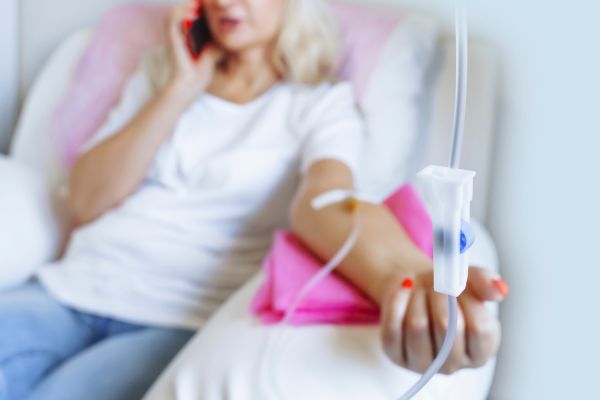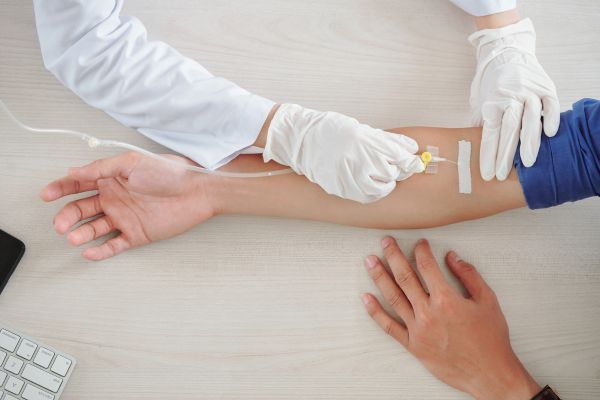What Are the Side Effects of IV Vitamin Therapy?
IV vitamin therapy is a popular treatment for rapid nutrient absorption, but it comes with potential risks. Common IV vitamin therapy side effects include:
- Mild issues: Bruising, swelling, and irritation at the injection site.
- More serious risks: Infections, blood clots, electrolyte imbalances, and vitamin toxicity (especially with A and D).
- High-risk cases: Those with kidney or heart conditions may experience complications like fluid overload.
To minimize risks, always seek treatment from a qualified professional, monitor dosages, and ensure sterile conditions.
When to Avoid Infusion Therapy Side Effects
While IV therapy offers many benefits, there are still certain infusion therapy complications that may follow. Sometimes, it’s just not worth taking the risk. For instance, in the case of kidney diseases, heart problems, hypertension, allergy, or pregnancy, we seriously advise against receiving IV therapy due to the infusion therapy side effects. It’s better to be safe, than sorry. So, ask for a professional’s opinion before making an appointment.
IV therapy is the infusion of fluids, medications, vitamins, and nutrients directly into the bloodstream. It is quick and effective treatment, but not without its risks. What may seem to be a very common therapy has some potential side effects, from mere discomfort at best to more serious complications. This paper explains the common side effects, risks, and factors contributing to these issues associated with IV therapy, mainly focusing on vitamin IV therapy.
Common Side Effects of IV Therapy
IV therapy, whether it be medication or vitamins, involves the insertion of a needle into a vein, usually that of the arm. While essentially a safe process, the procedure can cause a wide range of side effects at the site of insertion:
- Blood Vessel Damage: In the process of inserting the needle into the vein, damage may result to the vessel, mostly if it is not easily located. It may cause discomfort with minor injuries around the tissues.
- Bleeding and Bruising: Mild bleeding from the site of insertion is quite common, more so when the vein has been missed while inserting. Moreover, bruising can also occur due to blood leaking into the tissues from the punctured vein. It may cause discoloration for some days.
- Swelling and inflammation: Swelling may result from the infusion leaking out from the vein; in some cases, there will be a bit of inflammation of the veins. Phlebitis can develop due to the intravenous line being kept in for too long; this then causes tenderness, redness, and swelling.
- Hematoma: A hematoma is a localized collection of clotted blood under the skin; this is usually due to trauma during the insertion procedure. Though harmless, it may be uncomfortable and can sometimes take a little time to settle down.
- Infection: A certain infection at the insertion site can result if proper hygiene measures are not taken. Some of the early manifestations that may point to an infection include redness, warmth, tenderness, and pus formation. If severe, infections can diffuse and hence turn into a possible threat to a patient’s health.

Risks and Complications of IV Therapy
While this procedure is usually associated with minor side effects, serious complications can still result from it, especially when carried out by those who are not trained:
Allergic reactions:
A few patients would be allergic to the adhesive tape that helps in holding the IV in place, and such an allergy manifests itself in the form of skin rashes or itching, and even serious cases of swelling, with difficulty in breathing. IV therapy for cancer patients is often a critical component of treatment, used to deliver chemotherapy, hydration, pain management, and essential nutrients. While it provides vital support, it also carries specific risks and side effects that must be carefully monitored.

Blood Clots and Air Embolisms:
Obstruction of blood flow from the formation of blood clots at the point of insertion is quite a big risk factor. Sometimes, during the insertion of the IV, air bubbles may get into the bloodstream, which is known as an air embolism, and could lead to life-threatening situations.
Cellulitis and Abscess Formation:
Deep-reaching infections into the layers of skin can be a cause of cellulitis. It is an infection with severe swelling, redness, and pain. If left untreated, it could result in abscess formation—pockets of pus that need medical intervention.
Skin Necrosis:
Long-term use or improper use of IV therapy may lead to skin necrosis, a condition in which skin cells die earlier than normal. It can be painful and sometimes requires surgery to remove the infected tissue. On the other hand, when administered correctly, IV therapy for skin rejuvenation can be used, by delivering essential vitamins and antioxidants directly into the bloodstream, promoting healthier, more youthful-looking skin.
Fluid Overload and Electrolyte Imbalance:
IV therapy should be keenly monitored to avoid giving too much fluid, hence fluid overload. Such conditions may stress the heart, while at the same time causing swelling, and also altering electrolyte balance. For instance, if the amount of potassium is high, it results in cardiac problems like heart attacks.
Vitamin IV Therapy: Specific Side Effects

Meanwhile, vitamin IV therapy, to which high doses of vitamins are infused directly into the bloodstream, by passing the digestive system, has become popular for both its fast action and the ability to bypass the digestive system. It does not come without its own set of risks. Here are some of IV vitamin therapy side effects that you should know about:
Infection and Inflammation of the Vein:
This is a characteristic pathology associated with the administration of conventional IV insulin and should be expected when vitamin infusions are performed by nonprofessionals in nonsterile conditions.
Vitamin Toxicity:
For instance, vitamins A and D are treacherous in high doses. Too much of vitamin A may lead to symptoms ranging from headaches to damage to the liver, or even fatal diseases. The right amounts are crucial to avoid such situations. Similarly, weight loss IV drip must be carefully managed, as it often involves administering specific vitamins, minerals, and amino acids to boost metabolism and energy. While it can be an effective complement to a healthy diet and exercise, proper dosing is essential to ensure safety and effectiveness.
Electrolyte Imbalance:
Infusions containing electrolytes should be closely monitored. Too little or high imbalance of electrolytes may result in the following: dizziness, irregular heartbeats, muscle weakness. In case the patient is not treated urgently, it may result in death.
Contraindications to Certain Health Conditions:
Patients with kidney problems or heart problems have a higher risk. Their bodies may not be able to absorb or clear large volumes of vitamins and fluid fast enough from their system and may result in fluid retention, high blood pressure, or overwork of the kidneys.
Air Embolism and Clotting:
The danger of air embolism and blood clotting is as much there with this treatment as it is with the conventional use of IV therapy; similar can be reduced by ensuring the treatment is administered by only qualified and trained professionals. Air Embolism and Clotting: As with traditional IV therapy, there’s a risk of air embolism and blood clots, which can be minimized by ensuring that only trained professionals administer the treatment.
Related article: Read more about IV line and it’s benefits
Reducing Risks and Ensuring Safe IV Therapy
Given the probable IV vitamin therapy side effects, IV therapy should be conducted in a controlled medical setting. In such a setting, one can minimize complications if performed by a well-trained professional following strict steps and safeguards. Best practices are as follows:
Select a Reputable Provider:
Always avail of treatment by an experienced licensed medical professional who does IV therapy regularly. Qualified providers are less likely to make errors that could lead to complications.
Reactions:
With medications or vitamin infusions, one needs to monitor the reactions of the body to such. If you have a rash, difficulty breathing, or if you have severe pain at the insertion site, that needs to be addressed and brought to the attention of your provider.
Let the Doctor Know about Your Medical History:
Ensure that your health care provider is aware of your complete medical history, all allergies, or any current medications and sensitivity to them or any previous ill effects from IV therapy. It will help in working out the personalized treatment plans with less risk factors.
Good Hygiene and Sterility:
A good guideline in infection prevention would be the creation and maintenance of a sterile environment. The provider and the patient should ensure cleaning of the site of insertion and proper sterilization of the IV equipment.
Observe Dosages and Rates of Infusion: This is very critical—to give the right dose at the right rate of infusion, more so with vitamin IV therapy. High dosages and rates may lead to side effects and long-term damage.
[note text=’If you are looking for the Vitamin Drip in Dubai, Elegant Hoopoe is the best choice.’]
Conclusion: IV Therapy Side Effects
IV therapy is a pretty strong method to administer any kind of treatment quickly and effectively, but one should also be aware of the potential side effects and risks involved. Although this process causes minor discomfort for most, serious complications might still come up if it is not done properly. Be it medication, hydration, or even vitamin infusions, knowing the possible risks and how to minimize them will provide a much safer experience. Always obtain it from an approved, accredited provider and be alert to any IV vitamin therapy side effects by taking remedial action when complications set in.






